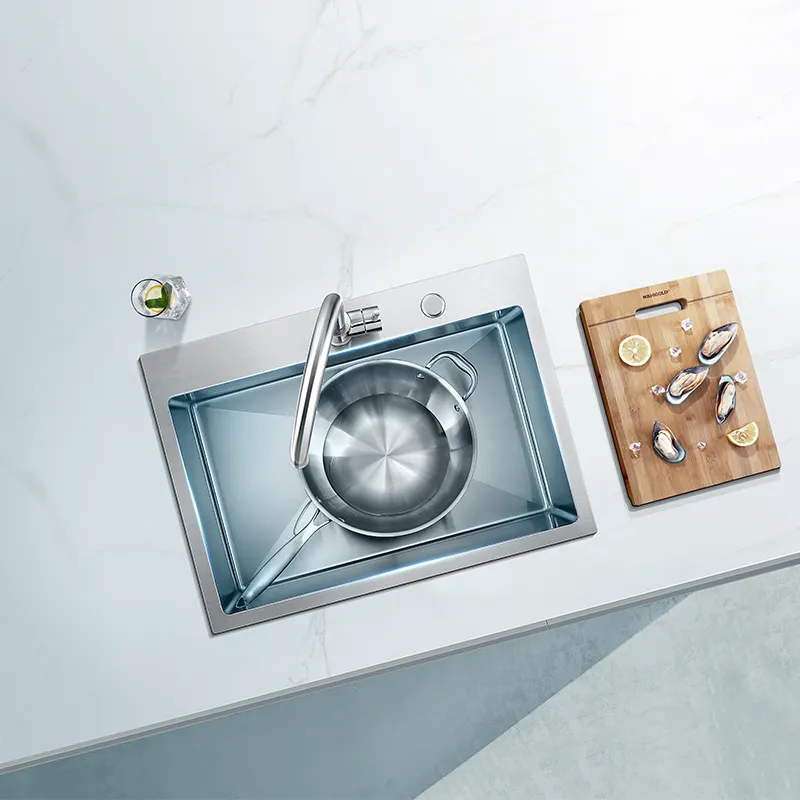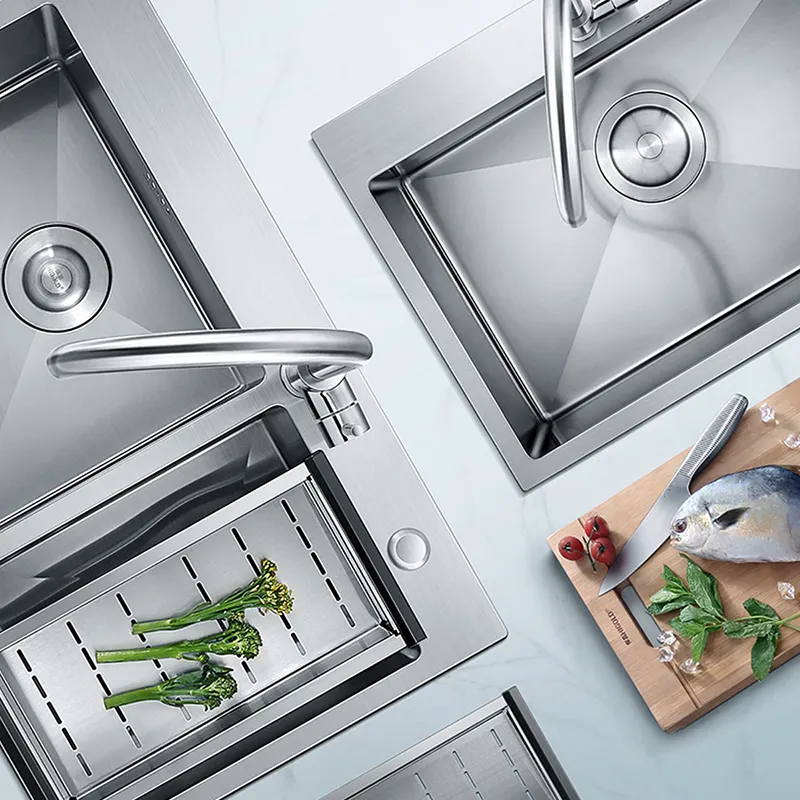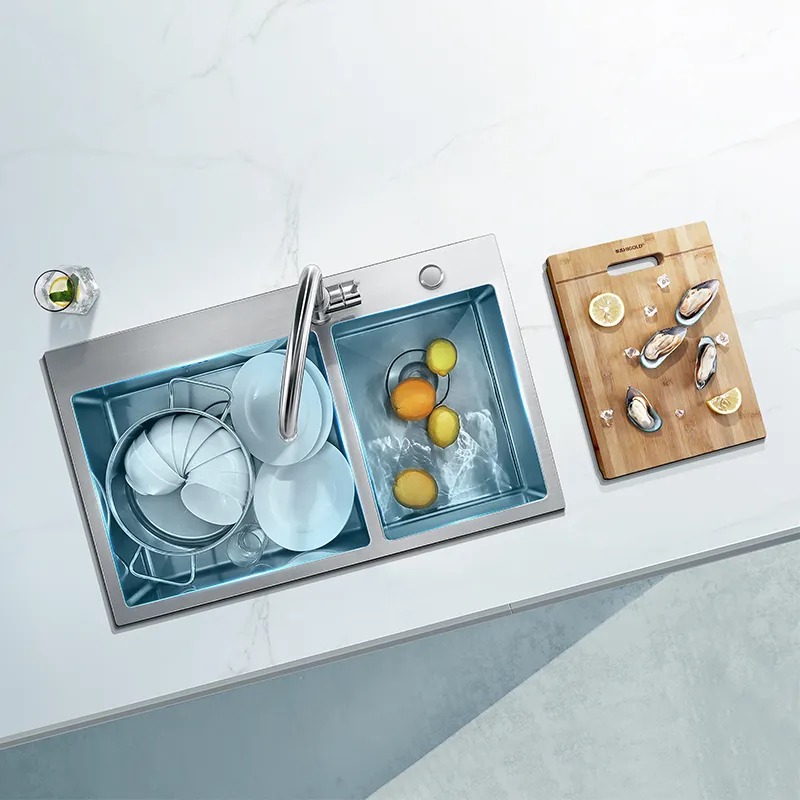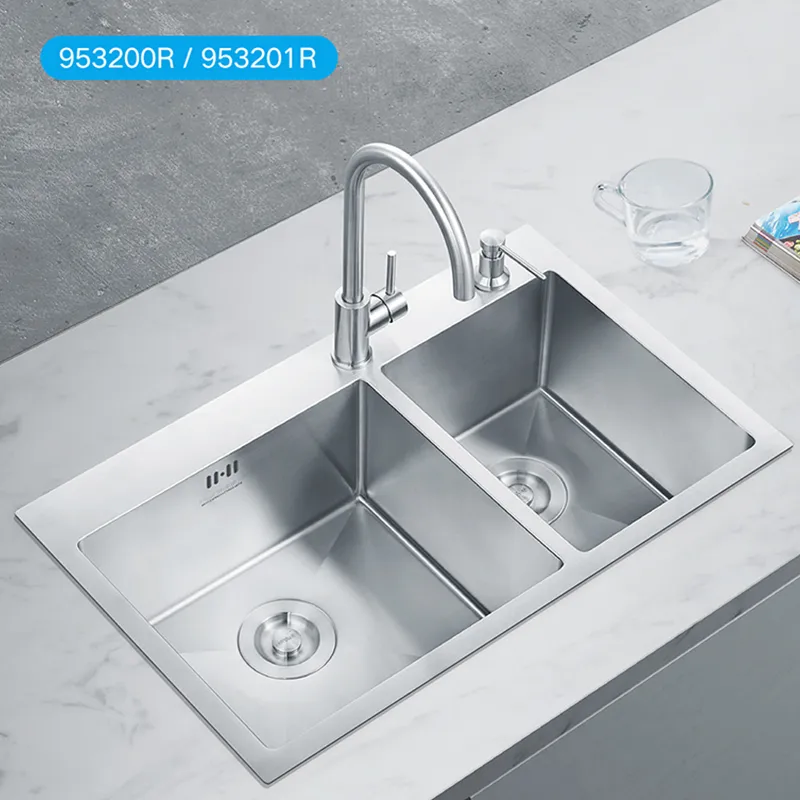In modern kitchen design, handmade stainless steel kitchen sinks are gradually replacing traditional stamped sinks, becoming one of the top choices for high-end kitchens.
As the name suggests, "handmade" means the sink is primarily made through manual bending, welding, and polishing processes, rather than being formed in a single stamping by machine molds.
The advantages of handmade production are:
• Customizable size and shape to fit different countertops;
• Uniform sink wall thickness, typically 1.2mm~1.5mm;
• Rugged lines, giving it a more modern look;
• Robust structure and long service life.
However, many consumers have a question when learning about handmade sinks:
"Do all handmade stainless steel kitchen sinks have welds? Will the welds affect their use?"
This is the core question that this article will explore in depth.

Why do handmade stainless steel kitchen sinks have welds?
1. The Manufacturing Process Determines the Existence of Welds
The biggest difference between handmade stainless steel kitchen sinks and traditional stamped sinks lies in their manufacturing method.
Stamped sinks are formed from a single sheet of stainless steel using a large stamping machine, with the body and corners naturally shaped without welding.
The manufacturing process of handmade sinks is completely different:
• Selecting a stainless steel sheet of suitable thickness;
• Cutting it into multiple panels (bottom, side, back, etc.) according to the design dimensions;
• Welding these panels into a single structure using argon arc welding or laser welding;
• Finally, grinding, polishing, and surface brushing are performed.
Therefore, welds are an inevitable part of the structure of handmade stainless steel kitchen sinks.
However, this does not mean that welds are defects; on the contrary, they reflect the precision and quality of the craftsmanship.
Where are the welds located in handmade stainless steel kitchen sinks?
For consumers unfamiliar with the manufacturing process, welds may be an "invisible" concept.
In fact, the location of welds in handcrafted stainless steel kitchen sinks follows certain patterns:
• Inner corner welds (around the four corners): The four corners of the sink are usually formed by splicing the base plate and side plates, with fine welds along the inner edges.
• External structural welds: In some double-bowl or stepped sinks, the bottom support structures are also welded together.
• Partition welds (double-bowl sinks): The partition between the two sections is also welded together to ensure overall stability and leak-proofness.
However, in high-quality products, these welds are usually finely ground and rounded, making them almost invisible to the naked eye.

Do welds affect the durability of handcrafted stainless steel kitchen sinks?
This is one of the most important questions for consumers.
1. Properly welded welds do not reduce strength
The TIG welding or laser welding techniques used in the manufacture of handcrafted sinks can fully fuse the stainless steel molecules at high temperatures, forming a high-strength bond.
The structural strength after welding is often comparable to that of the base material, and the load-bearing capacity is not reduced by the weld.
2. Properly treated welds will not leak or rust
High-end brands will perform the following treatments on the weld area:
• Double grinding (to remove weld slag and protrusions);
• Acid pickling and passivation treatment (to prevent corrosion);
• Surface brushing or matte finish (to match the overall sink).
Through these processes, the weld is not only smooth and even, but also maintains the same rust-resistant properties as the sink itself.
3. In fact, it is more resistant to deformation than stamped sinks
Handmade structures, due to the use of thicker steel plates and the support of a welded frame, have better overall rigidity than thin-plate stamped sinks, making them less prone to collapse or deformation.
Therefore, as long as the welding process meets standards, the weld will not be a weakness, but rather one of the guarantees of structural strength.
Does the weld affect the appearance of a handmade stainless steel kitchen sink?
1. High-quality welds are almost invisible
Modern welding technology is very mature, especially laser welding, which produces extremely fine, smooth weld lines. After precision grinding and polishing, the surface texture is consistent with the entire sink, making it difficult to distinguish with the naked eye.
2. Poor weld quality will expose problems
However, if low-quality processes are used or the workmanship is rough, the weld may exhibit:
• Obvious unevenness;
• Blackening or bluish discoloration of the surface;
• Rust spots after long-term use.
Therefore, when purchasing a handcrafted stainless steel kitchen sink, attention should be paid to the welding process description, brand reputation, and surface treatment details.
What types of welds are there in handcrafted stainless steel kitchen sinks?
To better understand the differences in welds, we can classify them according to the welding method:
1. TIG (Tungsten Inert Gas Welding)
• Characteristics: Uniform weld, strong corrosion resistance.
• Application: Most high-quality sinks use this method.
• Advantages: Dense weld points, less prone to leakage.
2. Laser Welding
• Characteristics: Small heat-affected zone, delicate and beautiful weld.
• Advantages: Almost no deformation; the weld seam is fused seamlessly with the base material.
• Cost: Higher, but with the best visual effect.
3. Spot welding or hand welding
• Characteristics: Mostly used for structural reinforcement.
• Advantages: Simple construction; Disadvantages: The appearance is not as refined as the previous two methods.
Therefore, the existence of weld seams is not a "defect," but rather reflects differences in manufacturing processes and quality levels.

Are weld seams prone to accumulating dirt?
Some users worry that weld seams might become unsanitary corners. In reality, if the craftsmanship is excellent, this concern is unnecessary.
1. Smoothly polished weld seams do not accumulate dirt
High-end hand-finished stainless steel kitchen sinks undergo mirror or brushed finishing after welding, resulting in a smooth, groove-free surface that does not retain stains or grease.
2. Regular cleaning prolongs the shine
Simply use a neutral detergent and a soft cloth to keep the weld area clean.
Avoid using abrasive cleaning tools such as steel wool to avoid scratching the welded surface.
Will the weld seams of a handmade stainless steel kitchen sink rust?
1. The corrosion resistance of stainless steel weld seams depends on post-treatment
During the welding process, chromium on the metal surface may be oxidized at high temperatures. Therefore, without passivation treatment, the corrosion resistance of the weld area will decrease.
Reputable manufacturers will perform pickling passivation or electrochemical polishing to restore the protective film layer of the stainless steel, giving the weld seam rust resistance.
2. Yellowing or blackening of weld seams is not rust
Some consumers mistakenly believe that changes in weld seam color indicate rust. In fact, this is the oxidation color caused by the metal being heated during welding, which can be removed with surface treatment.
Therefore, as long as you choose a high-quality brand and a product with qualified workmanship, the weld seams of a handmade stainless steel kitchen sink will not rust.
How to determine if the weld seam workmanship of a handmade stainless steel kitchen sink is up to standard?
During the purchase process, you can judge by the following points:
1. Observe whether the weld seam surface is smooth
Touch the inner corner with your hand. If there are no obvious protrusions or roughness, it indicates that the grinding process is proper.
2. Check for uniform color
A high-quality weld seam is the same color as the surrounding surface, without blackening, yellowing, or burn marks.
3. Check for continuous weld lines
The weld seam must be a complete closed line, without breaks or incomplete welds.
4. Pay attention to the manufacturer's technical specifications
Reputable brands will indicate the welding process type, such as "TIG welding" or "laser welding," indicating that their production process is controlled.
Through these details, you can quickly identify the manufacturing quality of a handcrafted stainless steel kitchen sink.
Differences in Weld Seams Between Stamped and Handmade Stainless Steel Kitchen Sinks
Comparison Items | Stamped Stainless Steel Sink | |
| Forming Method | Sheet metal splicing and welding | One-piece stamping |
Weld Seam Presence | Welded seams (required for manufacturing process) | Seamless |
| Wall Thickness | Uniform thickness (1.2-1.5mm) | Relatively thin (0.6-0.8mm) |
| Appearance Style | Sharp lines and straight angles | Rounded corners, traditional look |
| Customizability | High, custom sizes available | Low cost, limited by molds |
Structural Strength | More robust and stable | Relatively easy to deform |
| Cost | Higher height | Lower cost |
As you can see, although stamped sinks do not have weld seams, they are inferior to handcrafted sinks in thickness, strength, and customizability.
The presence of weld seams is a sign of "precision manufacturing," not a defect.

How to maintain the weld seam area of a handcrafted stainless steel kitchen sink?
To extend its lifespan and maintain its appearance, pay attention to the following:
• Daily cleaning: Use a neutral detergent and a sponge to gently wipe. Avoid using strong acidic or alkaline cleaners.
• Regular polishing: Gently wipe the surface with stainless steel-specific care oil to restore shine.
• Avoid impacts from hard objects: Avoid direct impacts to the weld seams with heavy objects.
• Keep dry: Wipe dry after use to prevent water residue from forming mineral spots.
Good maintenance habits will keep the weld seams of your handcrafted stainless steel kitchen sink looking new for longer.
Do all handcrafted stainless steel kitchen sinks have weld seams?
Yes. Weld seams are unavoidable in any handmade sink, whether single, double, or countertop.
Will the weld seams leak?
No. Qualified welds undergo high-temperature fusion and sealing tests to ensure 100% leak-proof performance.
Can the weld seams of a handcrafted stainless steel kitchen sink be completely invisible?
High-end laser welding can achieve "virtually invisible" seams, but this requires advanced technology and is more expensive.
What if the weld seams rust?
Clean with stainless steel-specific rust remover and keep the sink dry regularly to avoid prolonged water accumulation.
Does Higold only sell in China or also abroad?
Higold exports kitchen sinks and faucets to more than 86 countries and regions, making us a truly global supplier. At the same time, our distribution network covers over 100 cities in China. International buyers can buy directly from our factory with reliable delivery schedules and competitive pricing.
Whether you want wholesale supply or ODM-designed products, Higold offers both high quality and cost-effective purchasing options.


